细数Java项目中用过的配置文件(properties篇)
2020-04-12 16:02:29来源:博客园 阅读 ()

细数Java项目中用过的配置文件(properties篇)
灵魂拷问:在不重启服务的前提下,如何让配置修改生效的呢?有什么奇技淫巧吗?
灵魂拷问:在 Java 项目中,总能看到以 .properties 为后缀的文件踪影,这类配置文件是怎么加载的呢?
项目研发过程中,总会遇到一些经常改变的参数,比如要连接的数据库的连接地址、名称、用户名、密码;再比如访问三方服务的 URL 等等。考虑到程序的通用性,这些参数往往不能直接写死在程序里,通常借助配置文件来优雅处理。
在 Java 项目中,properties 文件当属使用较简单一类,不过虽然简单,还是要好好说说项目中都是怎么使用的,尝试通过源码解读,让你真正懂它,并带你深刻体会 Java 中重载的意义。
1. 虽说简单,格式还是要看一看。
相比上次谈及的 ini 配置文件,properties 文件格式没有 Section (节)的概念,反而是简单了不少。

上图是一个 jdbc 连接所需要的配置,其中以 # 开始的每一行是注释信息,而以等号分割的每行配置,就是常说的键-值对,等号左边的为 key(代码中的变量),等号右边的为 value(是依据实际场景而配置的值)。
2. 虽说简单,Java 源码还是去要看看。
在 Java 中提供了 java.util.Properties 类,主要用于对配置文件的读写操作。
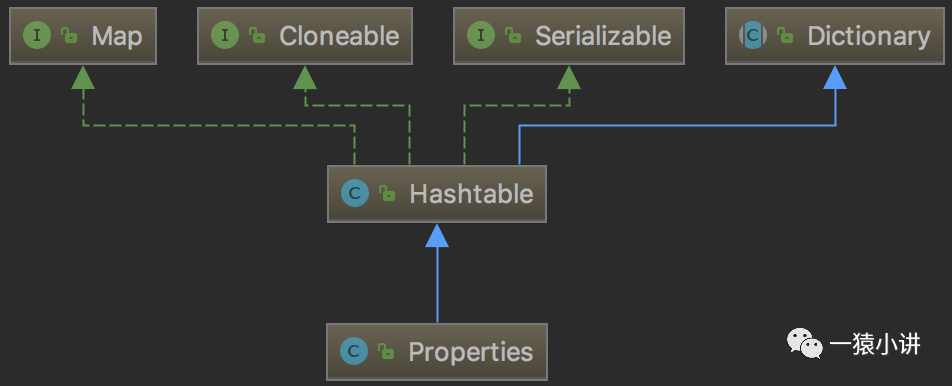
一图掌握血缘关系,很显然 Properties 继承自 Hashtable,归根结底是个 Map,而 Properties 最特殊的地方,就是它的键和值都是字符串类型。
从全局了解梗概,然后走进 JDK 源码,按照思路,步步去深入。
首先,要看看写好的配置文件是怎么加载的?

源码很清晰,提供字符流 Reader、字节流 InputStream两种方式加载配置文件(方法重载的目的:让使用者更方便),再深入去看最终会调用 Hashtable 的 put(key, value) 来设置键值对,最终完成配置文件中的加载。

然后,要看看怎么根据 key 获得对应的 value(放进去了,还要考虑拿出来)?

源码很清晰,通过参数 key 获得对应的 value,考虑到使用者的方便,对 getProperty 方法进行了重载,其中标注 2 的方法,当根据 key 获得值是 null 时,会返回一个调用方法时传入的默认值(很多场景下,确实很有用)。
知道了怎么加载配置文件,知道了怎么获取 key 对应的值,按照常理说,项目中已经够用了,但是有些时候项目启动后,还真需要再额外设置一下参数的值,不过没关系,因为 Java 已经想到了这一点,对外提供了 setProperty 的方法,让额外设置参数成为可能。
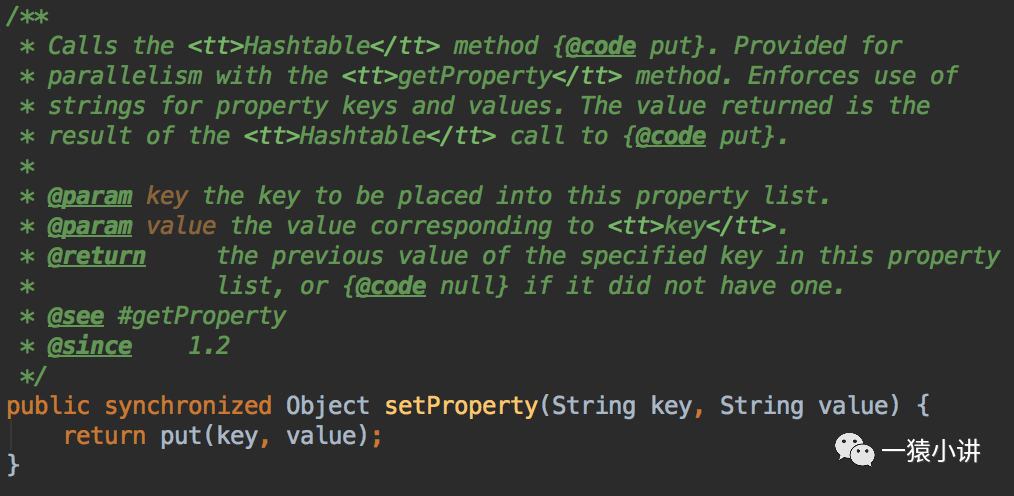
若能在项目研发中,熟练使用上面提到的这些 API,已经足矣。既然打开了源码,索性把杂七杂八的都提提,说不定某些 API 也能解决你碰到的其它场景的问题呢。
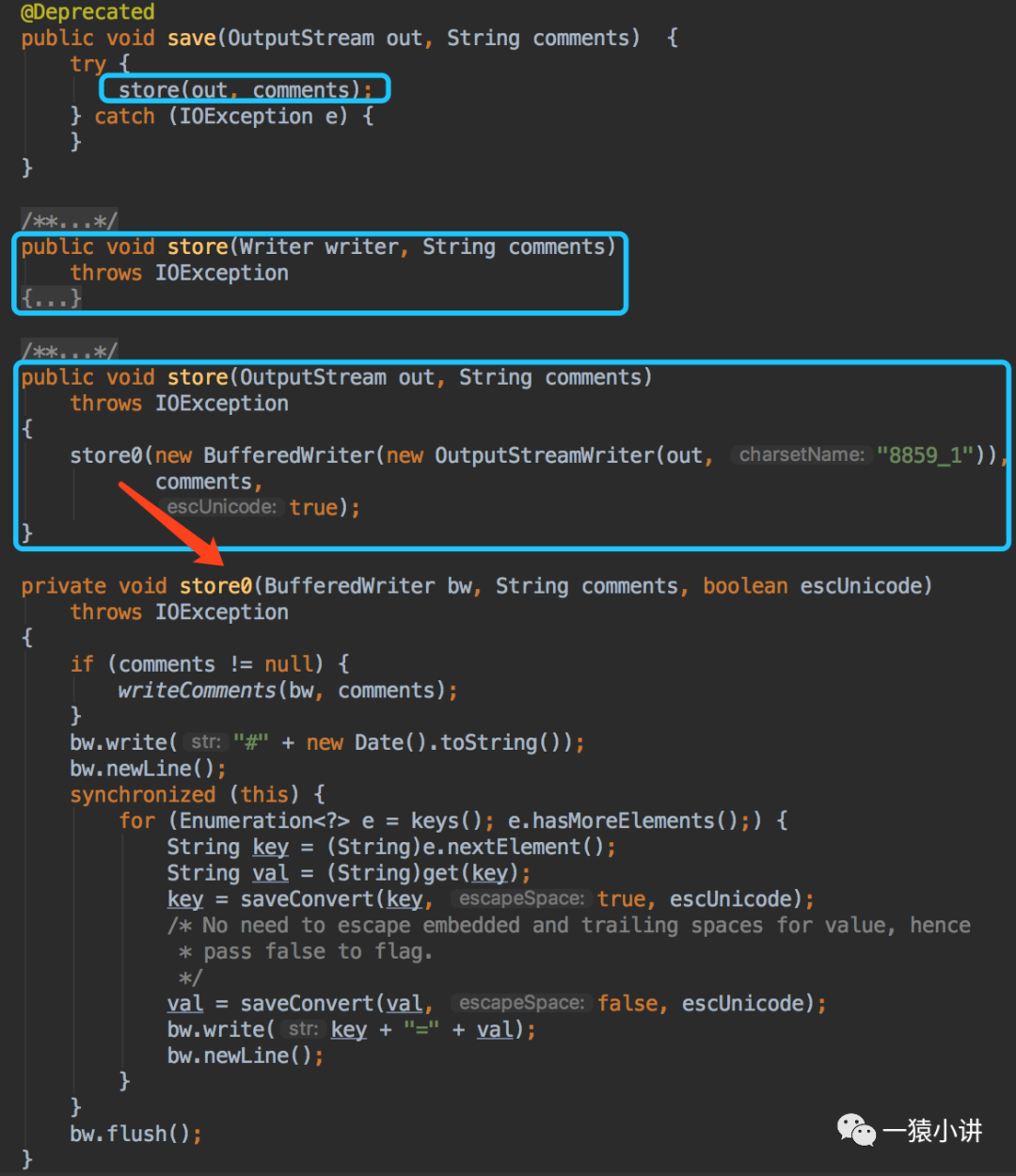
Properties 类不仅提供了 load 进行加载配置,而且还提供了把键值对写到文件中的能力。如上面源码所示,考虑到使用者的方便,对 store 方法进行重载,提供了面向字节流 OutputStream、字符流 Writer 两种方式的 store。
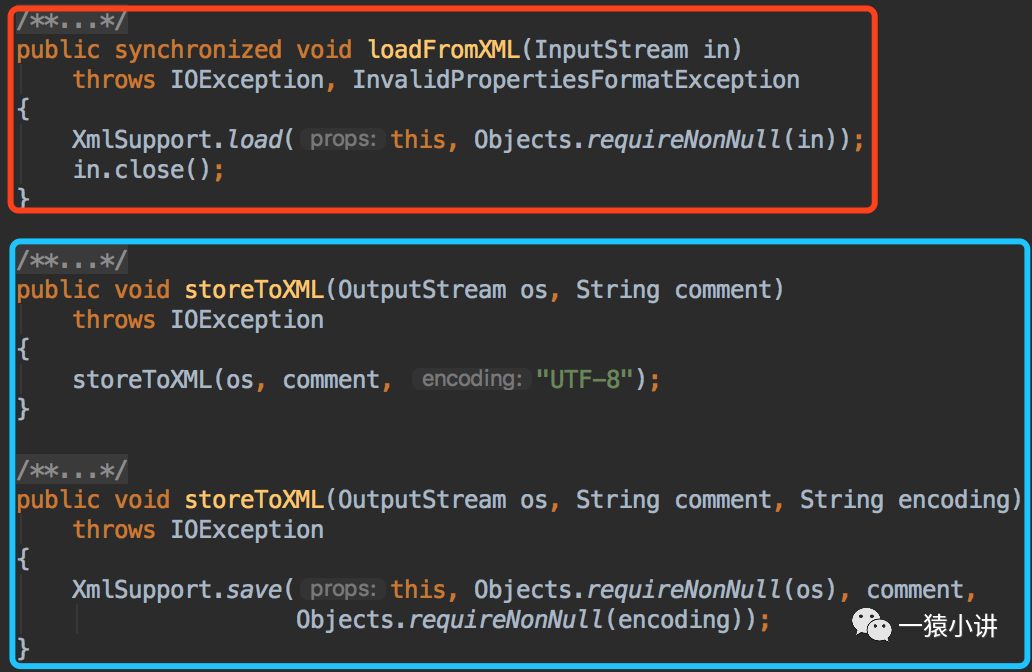
如上面源码所示,Properties 除了提供对常规配置文件读写能力支撑,对 xml 配置文件加载、写入也提供了支撑。

如上图源码所示,Properties 类提供了重载的 list 方法,为了方便调试,可以把键值对列表给整齐的打印出来。
3. 虽说简单,不能赋予实践一切都是扯淡。
场景一:在 APM 性能监控时,获取 Java 应用画像信息常用 API。
import java.util.Properties;
/**
* @author 一猿小讲
*/
public class JVMDetails {
public static void main(String[] args) {
// 获取系统信息(JDK信息、Java虚拟机信息、Java提供商信息、当前计算机用户信息)
Properties properties = System.getProperties();
// 把系统信息打印一下
properties.list(System.out);
}
}
程序跑起来,部分输出截图示意如下。
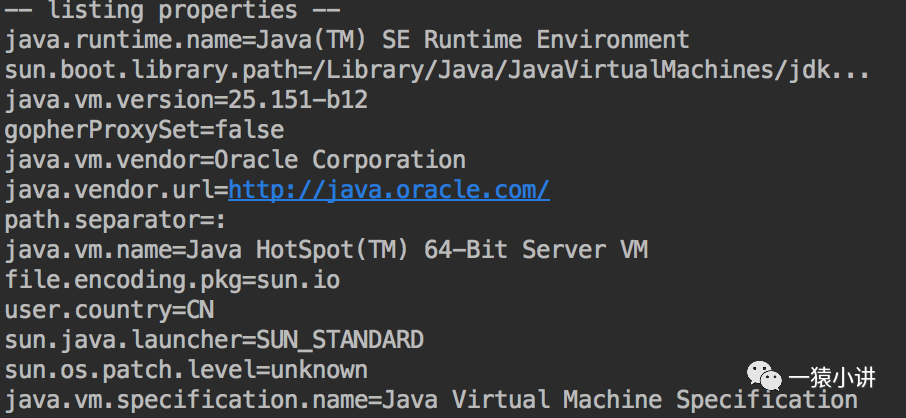
场景二:业务开发中,让配置替代硬编码,并考虑配置更新时,程序能够读到最新的值。
import java.io.*;
import java.util.Hashtable;
import java.util.Properties;
/**
* 配置文件工具类
* 1. 支持加载 .properties文件、.ini文件
* 2. 支持配置文件更新
* @author 一猿小讲
*/
public class PropertiesUtil {
// private static final Log4j LOG = .....;
private static Hashtable<String, PropCache> propCache = new Hashtable<String, PropCache>();
public static String getString(String propFile, String key) {
return getString(propFile, key, null);
}
public static String getString(String propFile, String key, String defaultValue) {
if ((!propFile.endsWith(".properties")) && (!propFile.endsWith(".ini"))) {
propFile = propFile + ".properties";
}
PropCache prop = propCache.get(propFile);
if (prop == null) {
try {
prop = new PropCache(propFile);
} catch (IOException e) {
// LOG.warn(e);
System.out.println(String.format("读取 %s 出现异常%s", propFile,e));
return defaultValue;
}
propCache.put(propFile, prop);
}
String value = prop.getProperty(key, defaultValue);
if (value != null) {
value = value.trim();
}
return value;
}
public static void setString(String propFile, String key, String value)
throws IOException {
if ((!propFile.endsWith(".properties")) && (!propFile.endsWith(".ini"))) {
propFile = propFile + ".properties";
}
File file = new File(propFile);
Properties prop = new Properties();
try {
FileInputStream fis = new FileInputStream(file);
prop.load(fis);
fis.close();
} catch (FileNotFoundException e) {
// LOG.warn(e);
System.out.println(String.format("文件 %s 不存在", propFile));
}
FileOutputStream fos = new FileOutputStream(file);
prop.put(key, value);
prop.store(fos, null);
fos.close();
PropCache localPropCache = propCache.get(propFile);
if (localPropCache != null) {
localPropCache.reload();
}
}
private static class PropCache {
private String fileName;
private long lastLoad;
private Properties prop;
public PropCache(String propFileName) throws IOException {
File file = new File(propFileName);
FileInputStream fis = new FileInputStream(file);
this.prop = new Properties();
this.prop.load(fis);
fis.close();
this.fileName = file.getAbsolutePath();
this.lastLoad = file.lastModified();
}
public String getProperty(String key, String defaultValue) {
File file = new File(this.fileName);
if (this.lastLoad < file.lastModified()) {
reload();
}
return this.prop.getProperty(key, defaultValue);
}
public void reload() {
File file = new File(this.fileName);
try {
Properties prop = new Properties();
FileInputStream fis = new FileInputStream(file);
prop.load(fis);
fis.close();
this.prop.clear();
this.prop.putAll(prop);
this.lastLoad = file.lastModified();
} catch (IOException e) {
// PropertiesUtil.LOG.warn(e);
System.out.println(String.format("文件 %s 重新加载出现异常%s", this.fileName, e));
}
// PropertiesUtil.LOG.all(new Object[]{this.fileName, " reloaded."});
System.out.println(String.format("文件 %s 重新加载完毕", this.fileName));
}
}
}
借助开篇提到的 jdbc 配置文件,进行验证。尝试获取数据库类型,默认配置为 db2,中途修改参数的值为 mysql,看看效果如何?
/**
* 测试类
* @author 一猿小讲
*/
public class M {
public static void main(String[] args) {
while(true) {
System.out.println(PropertiesUtil.getString("db", "jdbc.type"));
try {
Thread.sleep(10000);
} catch (InterruptedException e) {
}
}
}
}
程序跑起来,效果还是让人很满意。
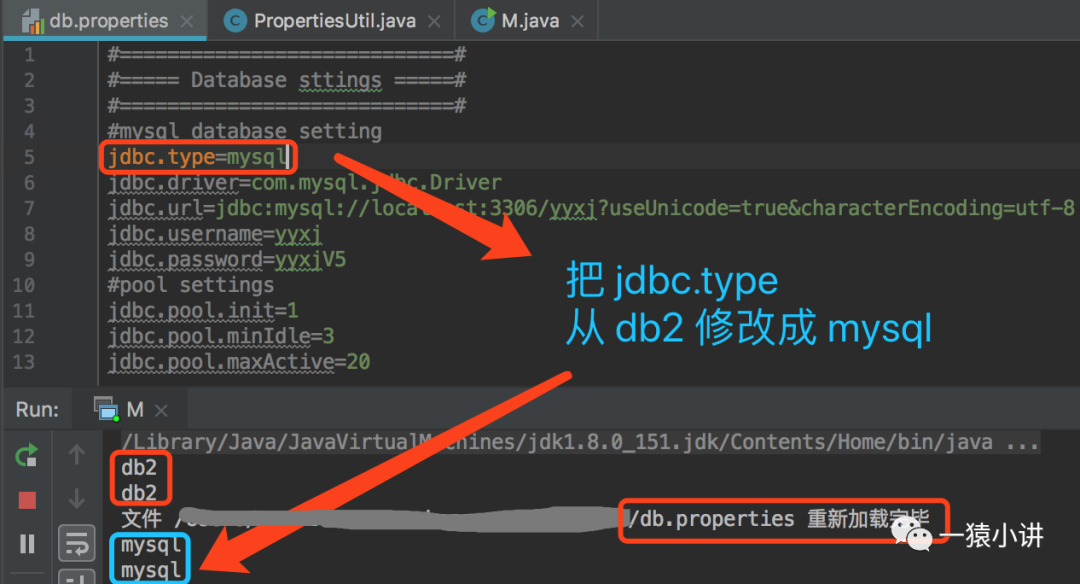
4. 虽说简单,洋洋洒洒分享一大篇。
有关配置文件的分享网上有很多,而我们的分享却显得不太一样。
我们的初衷是:结合实际项目及源码,说说这些年用过的那些有关配置的奇技淫巧,帮你提高研发能力(那怕是提高一丢丢,就算成功)。
它山之石可以攻玉,相信会对你有所帮助。
为了能够帮你提高研发能力(那怕是提高一丢丢呢),后续将继续结合实际项目,看看用到的其它形式的配置文件,敬请期待。

原文链接:https://www.cnblogs.com/socoool/p/12683501.html
如有疑问请与原作者联系
标签:
版权申明:本站文章部分自网络,如有侵权,请联系:west999com@outlook.com
特别注意:本站所有转载文章言论不代表本站观点,本站所提供的摄影照片,插画,设计作品,如需使用,请与原作者联系,版权归原作者所有
- 国外程序员整理的Java资源大全(全部是干货) 2020-06-12
- 2020年深圳中国平安各部门Java中级面试真题合集(附答案) 2020-06-11
- 2020年java就业前景 2020-06-11
- 04.Java基础语法 2020-06-11
- Java--反射(框架设计的灵魂)案例 2020-06-11
IDC资讯: 主机资讯 注册资讯 托管资讯 vps资讯 网站建设
网站运营: 建站经验 策划盈利 搜索优化 网站推广 免费资源
网络编程: Asp.Net编程 Asp编程 Php编程 Xml编程 Access Mssql Mysql 其它
服务器技术: Web服务器 Ftp服务器 Mail服务器 Dns服务器 安全防护
软件技巧: 其它软件 Word Excel Powerpoint Ghost Vista QQ空间 QQ FlashGet 迅雷
网页制作: FrontPages Dreamweaver Javascript css photoshop fireworks Flash
